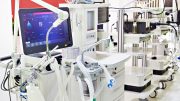The COVID-19 pandemic shook up industries across the globe, but none so much as healthcare. The industry has been put under immense strain trying to deal with the chaos caused by the pandemic. Healthcare organisations have not only been forced to adapt to remote working and remote medicine, but resources and capacity have also been maxed out while dealing with the burden of standard issues alongside the massive influx of COVID patients.
Despite this, innovation flourished in the face of adversity. The pandemic drove exciting developments in the rapid creation and launch of new vaccines. It also impacted the way that healthcare equipment is created, tested, and implemented in hospitals. Some nascent technologies like remote triage of patients, telemedicine, and IoT have all seen an acceleration in adoption and innovation as the industry pivoted to care for patients remotely. The art of the possible has translated into reality as the healthcare industry has managed to bring these early-stage technologies into everyday use.
However, with this surge in innovation, healthcare and life sciences organisations continue to face technical challenges which need to be addressed for optimal performance. Every new challenge seems to also bring a new piece of technology along with it. While it’s great news that tech can be used to solve some of the issues in healthcare, the additional hardware and systems bloat the tech stack and contribute to an increasingly muddied picture. These days Full Stack Observability (FSO) is less of a luxury and more a requirement for healthcare organisations as they deal with such a wide range of tech. The following sections will deep dive into the challenges facing the modern healthcare industry and how achieving observability can help mitigate these challenges.
What challenges is the healthcare sector currently facing?
Leveraging Big Data and Artificial Intelligence (AI)
Remote monitoring sensors (wearables) which find patterns in patient health data, as well as the results from drug and equipment tests, have grown exponentially in use. For example, according to statistica, the number of wearables has more than doubled in the space of three years, increasing from 325 million in 2016 to 722 million in 2019. The number of devices in use is forecast to reach more than one billion by 2022.
Healthcare providers need to be able to analyse the large amounts of data being produced by these devices. Being able to efficiently manage data from many disparate sources using AI will become crucial to these organisations as they continue to innovate and create new markets.
Finding the balance between telehealth and in-person healthcare
The pandemic forced most health consultations to be remotely delivered. It soon became clear, however, that not all platforms were compatible for remote consultation and not all types of assessment were possible outside of a healthcare facility. Inevitably, new systems and platforms were needed as a result of this.
To effectively roll out remote healthcare, it is essential to reinforce the link between virtual and in-person appointments. This is to ensure that follow-up appointments and prescriptions are delivered to patients, and technology can help to bridge this gap.
Securing the health supply chain
During the pandemic, the fragility of the healthcare supply chain was revealed. To help reduce the risks, healthcare organisations must identify and procure resources from multiple suppliers distributed across different geographies. In addition to this, smaller health authorities should consider joining together to form buying groups, in order to achieve economies of scale and obtain better pricing.
Forecasting trends to allow healthcare providers to meet demand
Being able to forecast trends in requirements for things such as PPE, vaccine supplies, and staffing for specific units enables healthcare organisations to better predict surges in demand. One of the reasons this can be so challenging is because it requires data sharing across multiple organisations and also geographies.
Navigating the new normal and the remote workforce
As the world races back to normality, for many organisations, it’s currently unclear what the future of the working landscape will look like with regards to a permanently remote, hybrid or in-person working setup. And more importantly, which approach will be most successful? Facilitating a permanently remote workforce is a common challenge across many industries. It requires new systems and procedures to ensure that staff have the right tools to do their jobs and that the business is properly secured.
In attempting to address each of these challenges, organisations are inevitably faced with a bigger challenge. With every new piece of technology added to their stack, the danger of siloes forming grows, whether by location or by function. Siloes may severely reduce overall visibility of operations, ultimately meaning that organisations do not have a full view of what is going on with all of their networks, applications and infrastructure. This can force IT teams to adopt a reactive approach to their jobs versus being proactive.
Observability is key to healthcare efficiency
Gaining full visibility is particularly tricky for healthcare providers given the wide variety of medical devices which must be monitored, as keeping track of them can seem like a full-time job. This is likely to cause further siloes and even greater loss of visibility.
Faced with large-scale, siloed systems that they don’t have full visibility across, IT leaders within the healthcare sector should consider implementing comprehensive monitoring and observability software that gives an organisation full visibility into and control over their devices, networks, applications, systems, and cloud infrastructure and on-premises infrastructure. As an organisation continues to expand its technology stack, implementing an AI-enabled FSO solution will ensure that siloes are eliminated and increase the overall efficiency of running multiple technologies. An intelligent observability platform will also enable IT departments to proactively predict outages and other issues in advance and take action prior to those issues affecting patients or providers.
Like many healthcare organisations, Bupa relies on a vast network infrastructure to support its key operations. Following a series of acquisitions in 2017, its IT team saw the need to streamline its network operations; the large number of different tools across different organisations within Bupa used for IT monitoring was not conducive to efficiency and cost saving. As a result, the healthcare organisation deployed a cloud-based observability and monitoring solution across its two main data centres. The platform allowed the IT team to quickly eliminate many of its historical monitoring tools, which streamlined its operations, and automated time-consuming processes to help the team improve overall IT efficiency.
The learning? Implementing FSO will help organisations to gain a comprehensive view of all of their networks, systems, applications and infrastructure layers. In turn, this full-stack visibility will allow IT teams to transition from a reactive to more proactive posture, and anticipate any disruptive outages or slowdowns before they occur to prevent impact to facilities and critical healthcare interfaces. After all, 24/7 care is only possible if the foundational technology modern healthcare is built upon continues to operate seamlessly, and observability will help countless organisations achieve precisely that.
By Adam Young Senior Manager, Sales Engineering, EMEA, LogicMonitor





